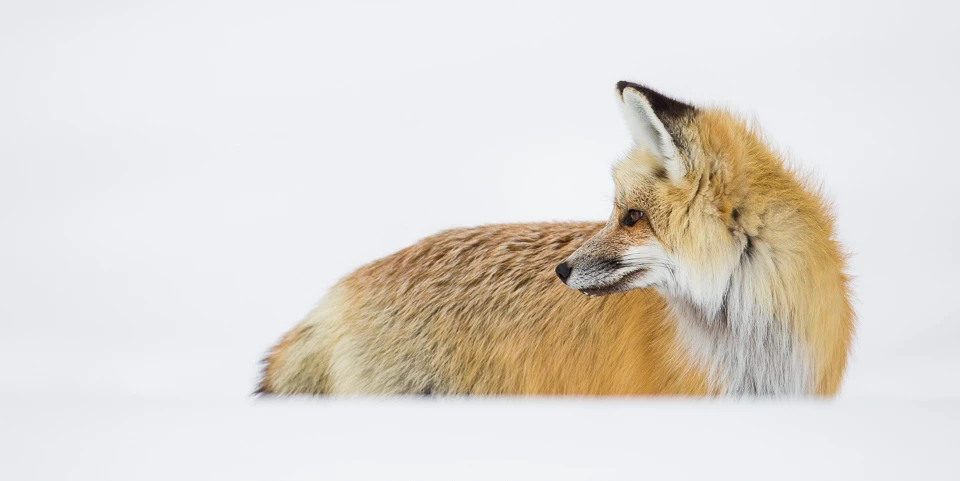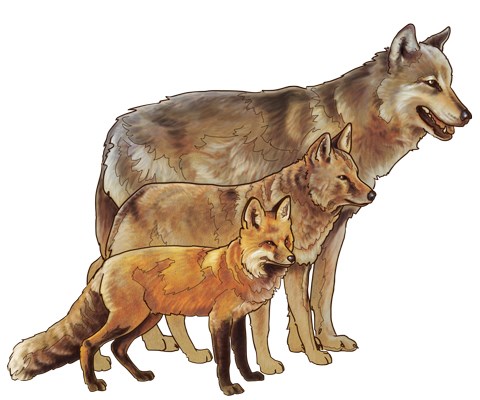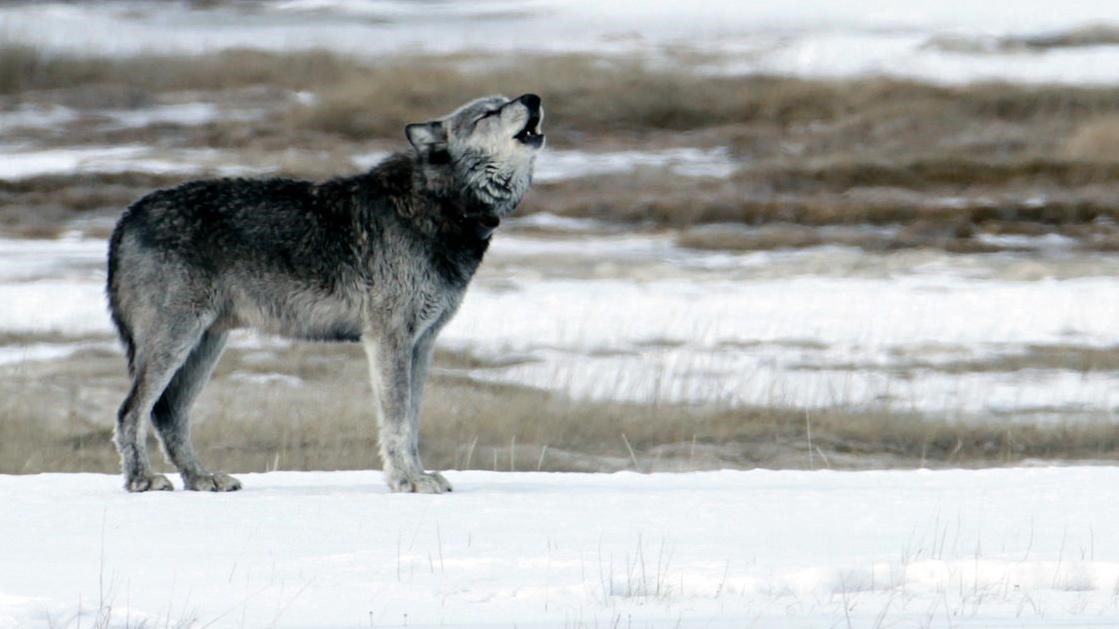
NPS / Neal Herbert The red fox (Vulpes vulpes) has been documented in Yellowstone since the 1880s. In relation to other canids in the park, red foxes are the smallest. Red foxes occur in several color phases, but they are usually distinguished from coyotes by their reddish yellow coat that is somewhat darker on the back and shoulders, with black “socks” on their lower legs. “Cross” phases of the red fox (a dark cross on their shoulders) have been reported a few times in recent years near Canyon and Lamar Valley. Also, a lighter-colored red fox has been seen at higher elevations. Three native subspecies exist at high elevations in the United States: the Sierra (V. v. necatar), Cascade (V. v. cascadensis), and Rocky (V. v. macroura) mountains and are collectively called mountain foxes. (Yellowstone’s fox is V. v. macroura.) Little is known about any of these subspecies. Most foxes in the lower 48 states, especially in the eastern and plains states, are a subspecies of fox from Europe introduced in the 1700s and 1800s for fox hunts and fur farms. The foxes that survived the hunt or escaped the fur farms proliferated and headed westward. 
Number in YellowstoneUnknown, but not nearly as numerous as coyotes. Where to See
Size and Behavior
PopulationRed foxes are more abundant than were previously thought in Yellowstone. The many miles of forest edge and extensive semi-open and canyon areas of the park seem to offer suitable habitat and food for foxes. They are widespread throughout the northern part of the park with somewhat patchy distribution elsewhere in the park. During the past century, especially within the past few decades, the number of fox sightings has significantly increased. This could be related to better documentation beginning in 1986. Wolves and coyotes are more closely related both genetically and physically than wolves and foxes. Wolves successfully competed with coyotes, causing a decline in the coyote population when they were reintroduced. This may have caused an increase in the number of fox sightings in core wolf areas such as the Lamar Valley. A research project conducted between 1994–1998 determined at least two subpopulations of foxes live in the Greater Yellowstone Ecosystem. At about 7,000 feet in elevation, there seemed to be a dividing line with no geographical barriers separating these foxes. The genetic difference between these foxes was similar to mainland and island populations of foxes in Australia and their habitat use was different as well. In addition, their actual dimensions, such as ear length and hind foot length, were adapted to some degree for colder environments with deep snow and long winters. A yellowish or cream color most often occurs above 7,000 feet in areas such as Cooke City and the Beartooth Plateau and is being studied by researchers. 
BehaviorFoxes are not often seen because they are nocturnal, usually forage alone, and travel along edges of meadows and forests. During winter, foxes may increase their activity around dawn and dusk, and even sometimes in broad daylight. In late April and May, when females are nursing kits at their dens, they are sometimes more visible during daylight hours, foraging busily to get enough food for their growing offspring. Recent research shows that red fox are more nocturnal than coyotes, and strongly prefer forested habitats, while coyotes tend to use sagebrush and open meadow areas. In this way, potential competition between fox and coyotes is minimized. Foxes do not seem to actively avoid coyotes during an average day, they just stick with forested habitat, sleep when coyotes are most active, and then forage opportunistically. Foxes will visit carcasses (e.g., wolf and cougar kills) for the occasional big meal, especially during winter, but this is more rare than the scavenging coyotes that park visitors can expect to see on many days, especially during winter. Data from remote camera studies in the park also show that coyotes and red foxes have opposite peaks and lulls in their daily activity patterns in winter months. This suggests some level of temporal avoidance is occurring, despite their ubiquitous occupancy of similar habitats. Furthermore, data suggests movement patterns and habitat use overlaps with top predators like wolves and cougars in a way that balances the risks and rewards of scavenging from predator kills given that these smaller canids are sometimes killed by the larger carnivores. Foxes can become habituated to humans usually due to being fed. In 1997, one fox was trapped and relocated three times from the Tower Fall parking area because visitors fed it human food. The fox was relocated between 10 and 60 miles away from Tower but it returned twice. Finally the fox came to Mammoth where it was fed again and as a result was killed by managers. While this story gives us interesting information about the homing instinct of fox, it also shows the importance of obeying rules to avoid inadvertently causing the death of one of Yellowstone’s animals. 
Mammals
Home to the largest concentration of mammals in the lower 48 states. ResourcesAlmberg, E. S., P. C. Cross, L. D. Mech, D. W. Smith, J. W. Sheldon, and R. L. Crabtree. 2011. Infectious diseases in Yellowstone’s canid community Yellowstone Science. vol. 19. Crabtree, R.L. 1998. On the trail of a gray ghost. National Wildlife 36(3):48. Crabtree, R.L. 1997. A new forest carnivore: Yellowstone’s mountain fox. National Wildlife 35. Crabtree, R.L. 1993. Gray ghost of the Beartooth: on the taxonomic trail of the mountain fox. Yellowstone Science 1:13–16. Crabtree, R.L., and J.W. Sheldon. 1999. Coyotes and canid coexistence in Yellowstone. Pages 127–163 in Clark, T.W., et al, editors. Carnivores in ecosystems: the Yellowstone experience. New Haven: Yale University Press. Fuhrmann, R.T. 2002. Tracking down Yellowstone’s red fox: Skis, satellites and historical sightings. Yellowstone Science 10:1. Fuhrmann, R.T. 1998. Distribution, morphology, and habitat use of the red fox in the northern Yellowstone ecosystem. M.S. Thesis. Bozeman: Montana State University. Gehrt, S.D. and W.R. Clark. 2003. Raccoons, coyotes, and reflections on the mesopredator release hypothesis. Wildlife Society Bulletin 31(3): 836–842. Gese, E.M. et al. 1996. Interactions between coyotes and red foxes in Yellowstone National Park, Wyoming. Journal of Mammology 77(2): 377–382. Kamler, J.F. and W.B. Ballard. 2002. A review of native and nonnative red foxes in North America. Wildlife Society Bulletin 30(2): 370–379. Swanson, B.J., R.T. Fuhrmann, and R.L. Crabtree. 2005. Elevational isolation of red fox populations in the Greater Yellowstone Ecosystem. Conservation Genetics 6:123–131. Van Etten, K.W., K.R. Wilson, and R.L. Crabtree. 2007. Habitat use of red foxes in Yellowstone National Park based on snow tracking and telemetry. Journal of Mammalogy 88:1498–1507. |
Last updated: April 18, 2025
